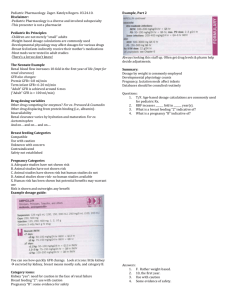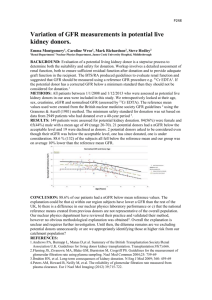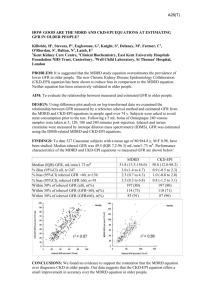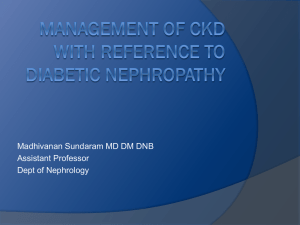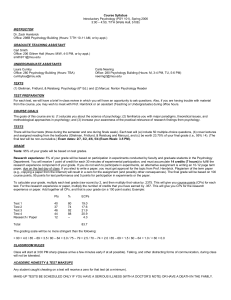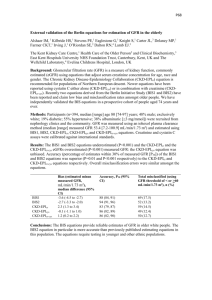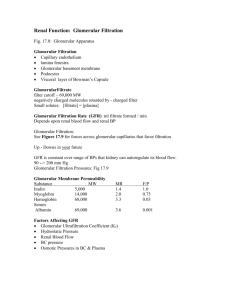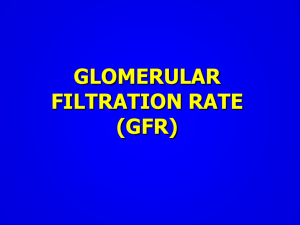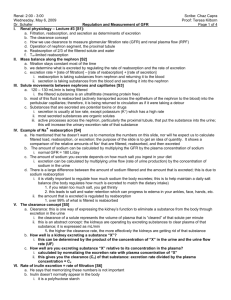Formulas used to compute GFR
advertisement
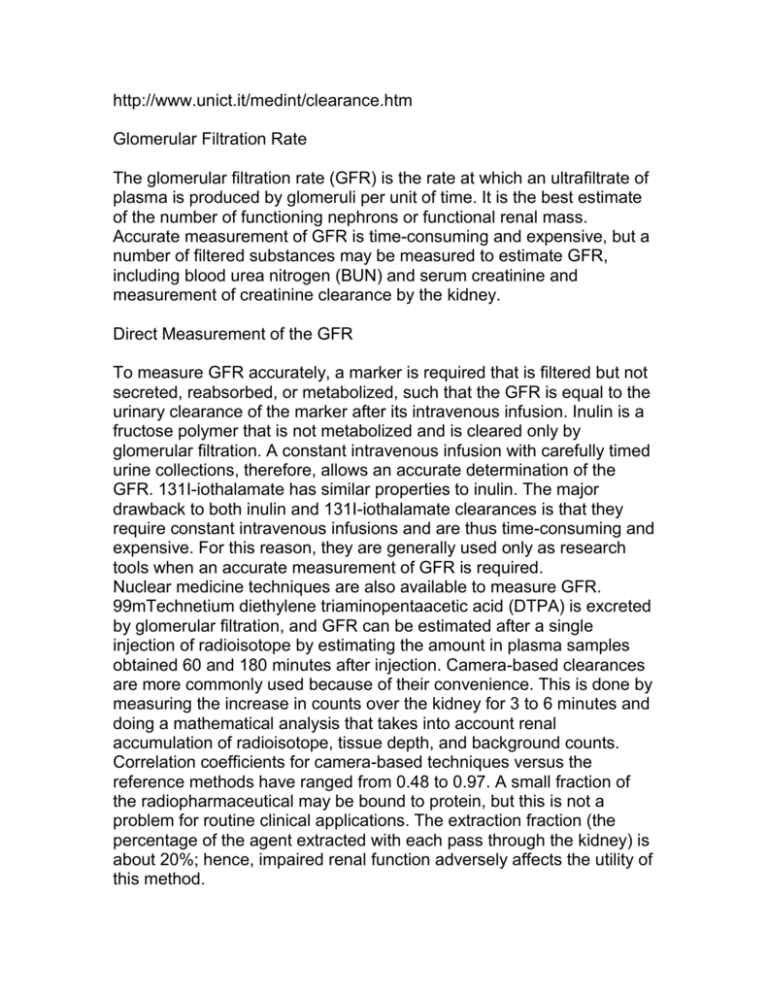
http://www.unict.it/medint/clearance.htm Glomerular Filtration Rate The glomerular filtration rate (GFR) is the rate at which an ultrafiltrate of plasma is produced by glomeruli per unit of time. It is the best estimate of the number of functioning nephrons or functional renal mass. Accurate measurement of GFR is time-consuming and expensive, but a number of filtered substances may be measured to estimate GFR, including blood urea nitrogen (BUN) and serum creatinine and measurement of creatinine clearance by the kidney. Direct Measurement of the GFR To measure GFR accurately, a marker is required that is filtered but not secreted, reabsorbed, or metabolized, such that the GFR is equal to the urinary clearance of the marker after its intravenous infusion. Inulin is a fructose polymer that is not metabolized and is cleared only by glomerular filtration. A constant intravenous infusion with carefully timed urine collections, therefore, allows an accurate determination of the GFR. 131I-iothalamate has similar properties to inulin. The major drawback to both inulin and 131I-iothalamate clearances is that they require constant intravenous infusions and are thus time-consuming and expensive. For this reason, they are generally used only as research tools when an accurate measurement of GFR is required. Nuclear medicine techniques are also available to measure GFR. 99mTechnetium diethylene triaminopentaacetic acid (DTPA) is excreted by glomerular filtration, and GFR can be estimated after a single injection of radioisotope by estimating the amount in plasma samples obtained 60 and 180 minutes after injection. Camera-based clearances are more commonly used because of their convenience. This is done by measuring the increase in counts over the kidney for 3 to 6 minutes and doing a mathematical analysis that takes into account renal accumulation of radioisotope, tissue depth, and background counts. Correlation coefficients for camera-based techniques versus the reference methods have ranged from 0.48 to 0.97. A small fraction of the radiopharmaceutical may be bound to protein, but this is not a problem for routine clinical applications. The extraction fraction (the percentage of the agent extracted with each pass through the kidney) is about 20%; hence, impaired renal function adversely affects the utility of this method. Recently, iohexol has been evaluated as an exogenous marker of GFR. Iohexol, a nonionic, low osmolar radiocontrast agent, may be measured in minute quantities by high-performance liquid chromatography. Extrarenal elimination is trivial. GFR may be determined by singlesample iohexol clearance 3 to 4 hours after the injection of 3 to 5 mL of iohexol. Initial investigations have suggested that renal clearance may be accurately measured in patients with GFRs as low as 2 to 3 mL/min. Indirect estimation/calculation of GFR: Formulas used to compute GFR Levey (MDRD) GFR = 170 * (Cr*113/10000)^0.999 (Age^-0.176) * (Ur*28/10)^-0.17 * (Alb/10)^0.318 (1-(Female*0.238))* (1+(Black*0.18)) Walser GFR = (-6.66+(1.85*Fe m a l e ) ) + ((7.57-(1.52*Female))/(Cr/1000)) + ((-0.103+(0.023*Female)) *Age) + ((0.096-(0.016*Female))*Wt) Jelliffe GFR = ((98-(16*(Age-20)/20))/(Cr*113/10000)) (1-(Female*0.1)) Cockcroft & Gault GFR = ((140-Age) * Wt (1-(Female*0.15)) / (72*(Cr*113/10000)) An easier way to do this (per K/DOQI) is: (140-age) x body wt 72x Cr then adjust for females = result x 0.85 Nankivell (Formula B) GFR = (6.7*1000/Cr) + (Wt/4) (Ur/2) - (100/Ht^2) + (35-(Female*10)) Notes: Cr = serum creatinine in µmol/L, Ur = serum urea in mmol/L Alb = serum albumin in g/L, Age is in years, Ht = height in m, Wt = weight in kg, Female = 1 for females else 0, Black = 1 for Afro-Caribbeans else 0 GFR is normalised to BSA = 1.73 m2, (except Walser (except Walser GFR which is n o rmalised to 3mHt2)


